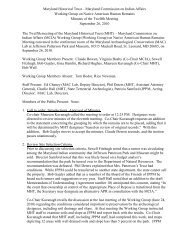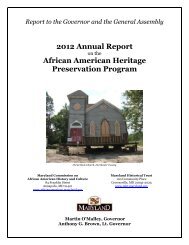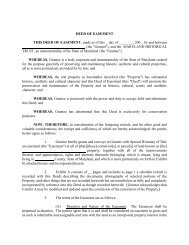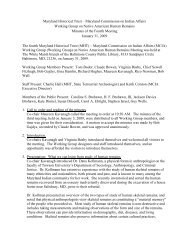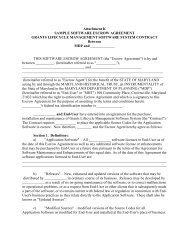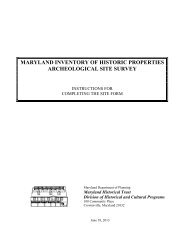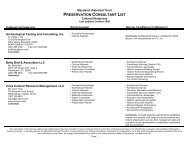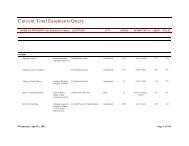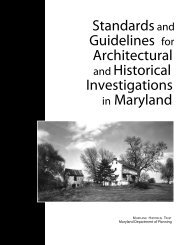The Maryland Preservation Plan - 2005 - Maryland Historical Trust
The Maryland Preservation Plan - 2005 - Maryland Historical Trust
The Maryland Preservation Plan - 2005 - Maryland Historical Trust
- No tags were found...
Create successful ePaper yourself
Turn your PDF publications into a flip-book with our unique Google optimized e-Paper software.
Statewide Priorities for Heritage Resource Conservationtion. Additional information and applications for this program are availablethrough the <strong>Maryland</strong> <strong>Historical</strong> <strong>Trust</strong>.State Rehabilitation Tax Credits<strong>The</strong> State rehabilitation tax credit program was created as part of theHeritage <strong>Preservation</strong> and Tourism Areas Act of 1996. <strong>The</strong> program has beenamended since its original enactment and now allows for a credit equal totwenty percent of the qualified capital costs expended in the rehabilitation of a“certified heritage structure.” <strong>The</strong> credit is available for owner-occupiedresidential property as well as income-producing property. <strong>The</strong> rehabilitationexpenditure in a twenty-four month period must be substantial, exceeding$5,000 for owner-occupied residential property, and the greater of the adjustedbasis of the structure for all other property. <strong>The</strong> rehabilitation must conformwith the Secretary of the Interior’s Standards for Rehabilitation and must becertified by the <strong>Maryland</strong> <strong>Historical</strong> <strong>Trust</strong>. Additional information and applicationmaterials are available from the <strong>Maryland</strong> <strong>Historical</strong> <strong>Trust</strong> web site.Local Government Property Tax CreditsState enabling legislation exists that allows local jurisdictions to enact aten percent rehabilitation property tax credit and/or a property tax freeze forowners of income-producing and owner-occupied residential properties.Eligibility for the program is based on the criteria developed by the local jurisdictions.2. Grants and Loans<strong>Maryland</strong> <strong>Historical</strong> <strong>Trust</strong> Grant Fund<strong>The</strong> <strong>Maryland</strong> <strong>Historical</strong> <strong>Trust</strong> Grant Fund includes both the Capital andNon-Capital Historic <strong>Preservation</strong> Grant Program and the Museum AdvancementProgram Grants (for cultural and history museums). <strong>The</strong> MHT Grant Fundis a continuing, nonlapsing, special fund consisting of monies the State appropriatesannually. <strong>The</strong> grants are awarded annually on a competitive basis.Nonprofit organizations, local jurisdictions, business entities and individualsmay apply for grants to fund capital projects, which include the acquisition,rehabilitation, or restoration of historic property in <strong>Maryland</strong>. Only nonprofitorganizations and local jurisdictions are eligible to apply for non-capitalgrants. Non-capital projects may include a wide array of preservation activitiesranging from research and survey work to the development of educationalprograms and planning documents. Both programs require a fifty/fifty match forgrants made to local jurisdictions; nonprofit organizations are not required toprovide a match (however, those that do so will be more competitive in thegrant selection process). <strong>The</strong> maximum grant award is $50,000.<strong>The</strong> Museum Advancement Program grant fund includes three types ofgrants: Museum Education and <strong>Plan</strong>ning Grants; Museum Project ChallengeGrants; and Museum Enhancement Challenge Grants. Museum Education and<strong>Plan</strong>ning Grants, which assist small institutions with institutional planning anddeveloping professional museum practices, are available for museums with abudget of less than $50,000. <strong>The</strong> maximum grant is $2,500 and a match, while<strong>The</strong> Secretary of the Interior’sStandards for Rehabilitation1. A property shall be used for its historicpurpose or be placed in a new use thatrequires minimal change to the definingcharacteristics of the building and its siteand environment.2. <strong>The</strong> historic character of a property shallbe retained and preserved. <strong>The</strong> removal ofhistoric materials or alteration of featuresand spaces that characterize a propertyshall be avoided.3. Each property shall be recognized as aphysical record of its time, place, and use.Changes that create a false sense ofhistorical development, such as addingconjectural features or architecturalelements from other buildings, shall not beundertaken.4. Most properties change over time; thosechanges that have acquired historicsignificance in their own right shall beretained and preserved.5. Distinctive features, finishes, andconstruction techniques or examples ofcraftsmanship that characterize a propertyshall be preserved.6. Deteriorated historic features shall berepaired rather than replaced. Where theseverity of deterioration requires replacementof a distinctive feature, the new featureshall match the old in design, color, texture,and other visual qualities and, wherepossible, materials. Replacement ofmissing features shall be substantiated bydocumentary, physical, or pictorial evidence.7. Chemical or physical treatments, such assandblasting, that cause damage to historicmaterials shall not be used. <strong>The</strong> surfacecleaning of structures, if appropriate, shallbe undertaken using the gentlest meanspossible.8. Significant archaeological resourcesaffected by a project shall be protected andpreserved. If such resources must bedisturbed, mitigation measures shall beundertaken.9. New additions, exterior alterations, orrelated new construction shall not destroyhistoric materials that characterize theproperty. <strong>The</strong> new work shall be differentiatedfrom the old and shall be compatiblewith the massing, size, scale, and architecturalfeatures to protect the historic integrityof the property and its environment.10. New additions and adjacent or relatednew construction shall be undertaken insuch a manner that if removed in the future,the essential form and integrity of thehistoric property and its environment wouldbe unimpaired.9



